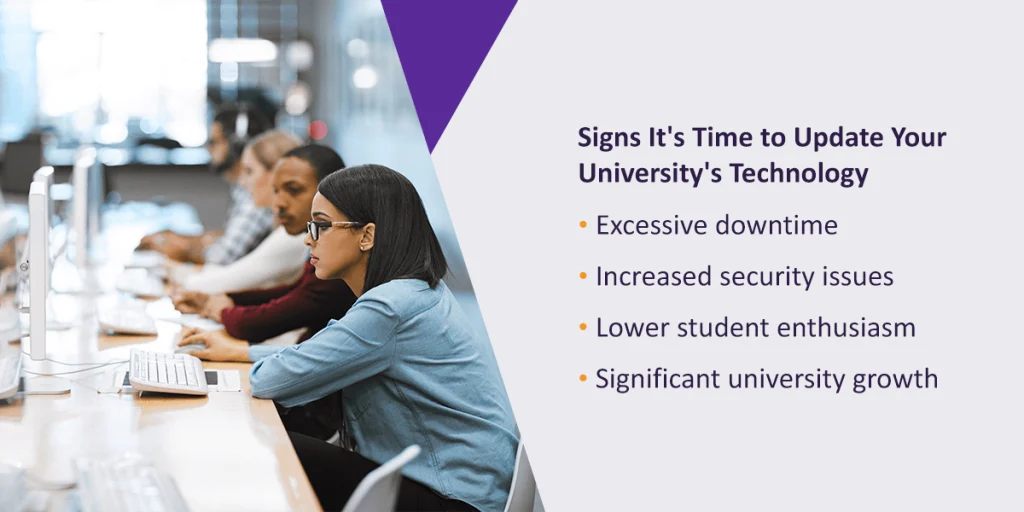
Universities rely on technology for many daily procedures. From taking student attendance to processing financial aid, these digital systems make it easier to complete many processes.
Your university’s use of technologies impacts efficiency and learning experiences. Using outdated or aging systems can obstruct growth instead of welcoming it. While digital upgrades can seem daunting, they bring countless advantages to your university’s operations. Learn more about the importance of updated technology and how it affects your university.
Importance of keeping technology up-to-date
Many universities cling to outdated systems because they still function well. If you’ve used a particular software for years, it’s challenging to transition to a new one. Technological transitions also require significant time and resources, which can feel daunting.
However, new digital solutions have the power to transform your university. Updated technology prepares you for success in our digital culture, setting you apart from other options. It can improve internal efficiency, appeal to the new generation of technology-savvy students, and diversify learning opportunities.
These are other reasons behind the importance of updated technology:
- Improving student engagement: Student engagement and satisfaction are crucial for universities. Higher satisfaction can increase your retention and enrollment rates, boosting overall success. Advanced technology helps you appeal to student preferences with data collection. These metrics allow you to study student behaviors and interests. Then, you can use the data to alter internal procedures and make more informed decisions. Other interactive options like artificial intelligence (AI) and collaboration tools make coursework more exciting.
- Increasing accessibility: Technology has made education more accessible for students around the world, as proved by the COVID-19 pandemic. Advanced digital solutions allow instructors to reach students in different locations or those with learning difficulties. You can improve student accessibility to class material, study resources, or collaborative tools.
- Preparing students for later success: Technology and digital solutions have rapidly changed our world. Students now graduate into a culture that prioritizes digital skills. By offering modern technology, you can equip students with the necessary tools for success.
- Enhancing creativity: You can also provide instructors with more creative options using advanced technology. They can adapt lessons to become more interactive, increasing student engagement. Digital solutions also assist with administrative procedures like updating grades, taking attendance, and managing student data. Streamlining these features with technology gives instructors more time for lesson preparation and personal research.
Signs it’s time to update your university’s technology
Transforming your university’s technology can seem overwhelming, especially if you like your current setup. But you might overlook indicators that a change is necessary. Legacy systems might work well, but they could keep your university stagnant instead of encouraging growth.

Here are a few signs you should update your university technology:
- Excessive downtime: Slow-loading systems cause interruptions for instructors and administrative workers. Whether it’s a slow computer that fails to load lecture slides or an internal system that saves data incorrectly, these outdated components make it harder to work efficiently. If your faculty and staff experience a lot of downtime, a technological upgrade can bring many benefits. You can streamline manual or repetitive tasks, allowing workers to focus on higher-priority tasks. Updated technology also makes classroom experiences more seamless for instructors.
- Increased security issues: Legacy systems can be prone to more security issues than newer ones. Because they don’t receive regular updates, the systems often can’t meet new advanced security challenges. If you notice an increase in security problems, it’s a big signal that you might need newer technology.
- Lower student enthusiasm: Interactive and upgraded technology can make classroom processes more engaging. Instructors might notice that students seem bored or less involved with class discussions, causing unsatisfactory learning experiences. If these problems persist, they can impact student retention and success. Upgraded technology can help students feel more engaged with learning content.
- Significant university growth: If your university experiences substantial increases in student enrollment, you might need updated technology to handle the growth. Most software programs are scalable, allowing you to increase data amounts as they grow. Outdated systems might be unable to support higher numbers, causing slow loading speeds or increased downtime.
Tips for updating technology at your university
Upgrading your university’s technology can bring many benefits to students and faculty. A successful implementation takes careful planning and support from employees and faculty. You can make the transition smoother with a thorough plan.
Here are a few tips for transforming university technology:
1. Focus on internal communication
Campus-wide changes require a lot of communication. You have to explain your reasoning for the changes, the potential benefits, and the overall implementation plan. Take time to gather your ideas and arrange them into a clear presentation. You can anticipate possible questions and concerns, building your resolutions into the explanation. University personnel can become more engaged with the new technology if they understand why the changes are necessary.
Focus on widespread communication to all affected people. Modern students are familiar with new technology and might be more welcoming to the changes than tenured faculty used to specific systems. You can use written and oral communication techniques to describe the new technology, how to use it, and how it affects daily procedures.
2. Offer many training opportunities
Training is essential for successful technology updates. Employees, faculty, and students must know how to correctly operate the software and devices. Luckily, most software providers offer training materials and ongoing assistance. You can share these tools with employees to help them transition more smoothly. Campus events with live instruction and examples are also beneficial. You could also provide refresher courses for staff throughout the year just in case they need additional help.
After a few years, some employees will have mastered the new technology and can lend their expertise to others. Internal collaboration makes it easier to discuss the changes and share tips for usage.
Provide students with helpful resources and tips, too. Younger students are more familiar with the use of technology than ever before, making upgrades easier for them to understand. Faculty and staff can choose how much the updates impact their courses.
3. Relate the changes to your university’s mission
It’s also helpful to remember your university’s mission during the alterations. Change can be hard, and convincing others to get on board might take more time than you think. New technology transforms existing procedures into more student-focused models. You meet the challenges of our digital environment and provide students with the tools for success. Remembering your university’s values can help you guide the implementation process in the right direction.
4. Update your technology with Watermark
By updating your institution’s technology, you benefit employees and students alike. Transform your technology today with Watermark’s many digital solutions. Our tools can help with everything from course evaluations to student assessment procedures. Give students the tools they need to thrive in our modern, digital world with our integrated solutions.
Learn more about how Watermark can help with university technology by requesting a demo today.
















































































































































































































































































































































































































